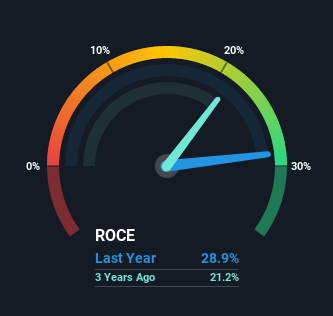Ingersoll-Rand (India) (NSE:INGERRAND) Could Become A Multi-Bagger
Did you know there are some financial metrics that can provide clues of a potential multi-bagger? One common approach is to try and find a company with returns on capital employed (ROCE) that are increasing, in conjunction with a growing amount of capital employed. Put simply, these types of businesses are compounding machines, meaning they are continually reinvesting their earnings at ever-higher rates of return. And in light of that, the trends we're seeing at Ingersoll-Rand (India)'s (NSE:INGERRAND) look very promising so lets take a look.
What is Return On Capital Employed (ROCE)?
Just to clarify if you're unsure, ROCE is a metric for evaluating how much pre-tax income (in percentage terms) a company earns on the capital invested in its business. Analysts use this formula to calculate it for Ingersoll-Rand (India):
Return on Capital Employed = Earnings Before Interest and Tax (EBIT) ÷ (Total Assets - Current Liabilities)
0.29 = ₹1.5b ÷ (₹7.7b - ₹2.7b) (Based on the trailing twelve months to December 2021).
So, Ingersoll-Rand (India) has an ROCE of 29%. In absolute terms that's a great return and it's even better than the Machinery industry average of 15%.
View our latest analysis for Ingersoll-Rand (India)

Historical performance is a great place to start when researching a stock so above you can see the gauge for Ingersoll-Rand (India)'s ROCE against it's prior returns. If you're interested in investigating Ingersoll-Rand (India)'s past further, check out this free graph of past earnings, revenue and cash flow.
The Trend Of ROCE
Ingersoll-Rand (India) has not disappointed in regards to ROCE growth. The figures show that over the last five years, returns on capital have grown by 569%. That's a very favorable trend because this means that the company is earning more per dollar of capital that's being employed. Interestingly, the business may be becoming more efficient because it's applying 51% less capital than it was five years ago. A business that's shrinking its asset base like this isn't usually typical of a soon to be multi-bagger company.
For the record though, there was a noticeable increase in the company's current liabilities over the period, so we would attribute some of the ROCE growth to that. The current liabilities has increased to 35% of total assets, so the business is now more funded by the likes of its suppliers or short-term creditors. Keep an eye out for future increases because when the ratio of current liabilities to total assets gets particularly high, this can introduce some new risks for the business.
The Key Takeaway
In summary, it's great to see that Ingersoll-Rand (India) has been able to turn things around and earn higher returns on lower amounts of capital. And with the stock having performed exceptionally well over the last five years, these patterns are being accounted for by investors. In light of that, we think it's worth looking further into this stock because if Ingersoll-Rand (India) can keep these trends up, it could have a bright future ahead.
Before jumping to any conclusions though, we need to know what value we're getting for the current share price. That's where you can check out our FREE intrinsic value estimation that compares the share price and estimated value.
High returns are a key ingredient to strong performance, so check out our free list ofstocks earning high returns on equity with solid balance sheets.
New: AI Stock Screener & Alerts
Our new AI Stock Screener scans the market every day to uncover opportunities.
• Dividend Powerhouses (3%+ Yield)
• Undervalued Small Caps with Insider Buying
• High growth Tech and AI Companies
Or build your own from over 50 metrics.
Have feedback on this article? Concerned about the content? Get in touch with us directly. Alternatively, email editorial-team (at) simplywallst.com.
This article by Simply Wall St is general in nature. We provide commentary based on historical data and analyst forecasts only using an unbiased methodology and our articles are not intended to be financial advice. It does not constitute a recommendation to buy or sell any stock, and does not take account of your objectives, or your financial situation. We aim to bring you long-term focused analysis driven by fundamental data. Note that our analysis may not factor in the latest price-sensitive company announcements or qualitative material. Simply Wall St has no position in any stocks mentioned.
About NSEI:INGERRAND
Ingersoll-Rand (India)
Manufactures and sells industrial air compressors and related services in India.
Flawless balance sheet with solid track record.
Market Insights
Community Narratives




